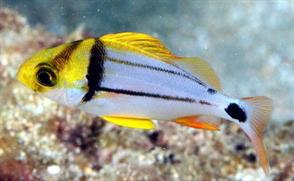



Anisotremus virginicus
| Ecological Descriptors |
||||
| Habitat | Size (cm) | Diet | Behaviour | Sex |
| Co, R, Man | 40 | Cru, Mol, Wor, Echinoderms Noct | Sh | F |
Description:
Adult: Body deep and laterally compressed, with high back profile. Longitudinally sriped alternating yellow and silvery blue, with yellow fins and tail. It has 2 black bars - one from nape through eye to mouth, another from origin of dorsal fin to base of pectoral fin. It is the only grunt fish in the Antigua with two vertical black bars and yellow stripes
Juvenile: Silver blue with yellow and with pectoral, pelvic anal and first dorsal fin yellow. Second dorsal clear. Tail clear lobes but may have with yellow stripe at top and bottom. Two longitudinal black stripes, one from eye to tail and one above. Black spot on upper dorsal peduncle and black spot at base of tail.
Ecology
Inhabits hardbottom and corals, shallow reefs, shelf-edge deep reefs and can be found in tidepools and mangroves at depths of 2 to 20m. It often colonizes artificial reefs and like many grunts can be found in highly altered habitats, e.g. harbors. It is a nocturnal forager of mollusks, echinoderms, annelids, and crustaceans. It also exhibits cleaning behavior and is known to forage on the surface of sea turtle shells. Usually seen in small aggregations.
Life Cycle
Atlantic porkfish are known to be pelagic egg layers, common in reefdwelling fish. Pelagic spawners lay their eggs directly into the open water. The eggs of the porkfish are easily carried by the ocean currents due to their small size and buoyancy. When
hatched, the planktonic larvae settle in well covered areas such as beds of sea grass or muddy bottoms. The porkfish larvae have a black spot on the caudal fin and this remains throughout its juvenile life.
Adult: Body deep and laterally compressed, with high back profile. Longitudinally sriped alternating yellow and silvery blue, with yellow fins and tail. It has 2 black bars - one from nape through eye to mouth, another from origin of dorsal fin to base of pectoral fin. It is the only grunt fish in the Antigua with two vertical black bars and yellow stripes
Juvenile: Silver blue with yellow and with pectoral, pelvic anal and first dorsal fin yellow. Second dorsal clear. Tail clear lobes but may have with yellow stripe at top and bottom. Two longitudinal black stripes, one from eye to tail and one above. Black spot on upper dorsal peduncle and black spot at base of tail.
Ecology
Inhabits hardbottom and corals, shallow reefs, shelf-edge deep reefs and can be found in tidepools and mangroves at depths of 2 to 20m. It often colonizes artificial reefs and like many grunts can be found in highly altered habitats, e.g. harbors. It is a nocturnal forager of mollusks, echinoderms, annelids, and crustaceans. It also exhibits cleaning behavior and is known to forage on the surface of sea turtle shells. Usually seen in small aggregations.
Life Cycle
Atlantic porkfish are known to be pelagic egg layers, common in reefdwelling fish. Pelagic spawners lay their eggs directly into the open water. The eggs of the porkfish are easily carried by the ocean currents due to their small size and buoyancy. When
hatched, the planktonic larvae settle in well covered areas such as beds of sea grass or muddy bottoms. The porkfish larvae have a black spot on the caudal fin and this remains throughout its juvenile life.
Porkfish Adult
Porkfish Juvenile

Porkfish Intermediate

(C) Kevin Bryant

(C) ZZBot




37


615

